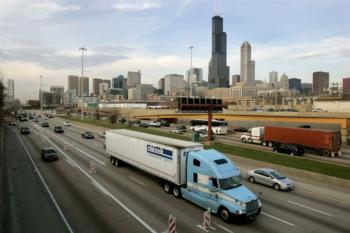Feds Need Interagency Connected Vehicle Office: Rep. Lipinski
Burney Simpson
Autonomous technology could well be part of the multi-year surface transportation reauthorization bill making its way through Congress, due in part to Rep. Daniel Lipinski, a Chicago Democrat, transportation committee veteran, and one of the dozen House members with an engineering degree.
Lipinski is a member of the conference committee charged with reconciling the Senate and House transportation bills that have already passed.
Lipinski laid the foundation for federal support for automated technology with three programs that he included in the House version of the transportation bill.
He’d like to see the establishment of an “autonomous and connected vehicle research center … a report on the readiness of the Department of Transportation for connected vehicles,” … and “the creation of an interagency group to coordinate research, technology commercialization, and workforce development” in the automated and connected vehicle sector, according to a column he wrote this month for Roll Call.
Lipinski did not spell out specifics on each of his goals, though he is adamant that a study be done on the DOT’s work in the connected sector, and he has met with Gregory Winfree, the agency’s assistant secretary for research and technology, to discuss a coordinated approach by Washington.
“The federal government agencies do not always communicate with each other,” said Lipinski. “This is designed to try to make sure more coordination is there. They do various related research projects but there is no connection among the different agencies.”
Meanwhile, the DOT itself needs to make autonomous and connected vehicles a top priority. One aspect of that is getting behind a university-based research center for the technology.
TECHNOLOGY BELIEVER
Lipinski is a believer in automated vehicle technology and the safer roads it can bring. About 18 months ago he rode in a prototype autonomous vehicle that Carnegie Mellon brought to Capitol Hill, then visited Silicon Valley to see the work going on around transportation and mobility.
Earlier this year, Lipinski joined with Rep. Joe Heck, a Nevada Republican, to re-launch the Congressional Unmanned Systems Caucus, designed to be a bipartisan education center on air-, marine- and land-based autonomous systems.
 Lipinski was first elected in 2004 from Illinois’ 3rd Congressional District, home to Midway Airport, huge rail and truck freight operations, and the Argonne National Laboratory. Prior to Congress, Lipinski taught at Notre Dame and the University of Tennessee. He has engineering degrees from Northwestern and Stanford.
Lipinski was first elected in 2004 from Illinois’ 3rd Congressional District, home to Midway Airport, huge rail and truck freight operations, and the Argonne National Laboratory. Prior to Congress, Lipinski taught at Notre Dame and the University of Tennessee. He has engineering degrees from Northwestern and Stanford.
Autonomous and connected vehicles are revolutionary in so many ways – safety benefits, job creation, and changes in mobility just for starters – that it is inevitable that the government will be involved, he says.
“I know that government will play an important role. At its worst it will impede the private sector. At its best it can speed it up and make sure it is to the best public benefit,” Lipinski said.
His concern is that the federal bureaucracy doesn’t understand the topic, will be left behind by the fast-moving private sector, and, even worse, could stand in the way of its development.
“I’m on the Transportation (and Infrastructure) Committee but there’s almost no talk about autonomous and connected vehicles,” he said. “Most of the focus is on building and repairing roads. There’s not a lot of forward thinking, not a lot of focus on how technology can impact the future of transportation.”
PAYING FOR THE FUTURE
Connected vehicles may be that future, but they can’t work at their full potential unless the roadside infrastructure is in place that communicates road conditions, weather, and other travel information to the vehicles, he argues.
“(R)oad infrastructure must be connected to the car. The government has got to put in the infrastructure,” he said. “Government has to do everything it can to get this communication system in place.”
One issue of course is paying for the Vehicle-to-Infrastructure (V2I) equipment needed. In a study conducted at Lipinski’s request the General Accountability Office in October reported that installing a single roadside V2I system could cost more than $50,000 (“Each V2I Site Could Cost $51,650”).
“Local governments are largely responsible for this. They need help from the (federal government) and we’re not doing enough now. Cost will be a problem,” he said.
The conference committee will decide if any of Lipinski’s three programs make it into the final transportation reauthorization bill. Political leaders of both parties are eager to see a bill completed and sent to the President, and that should happen before Christmas, says Lipinski.

